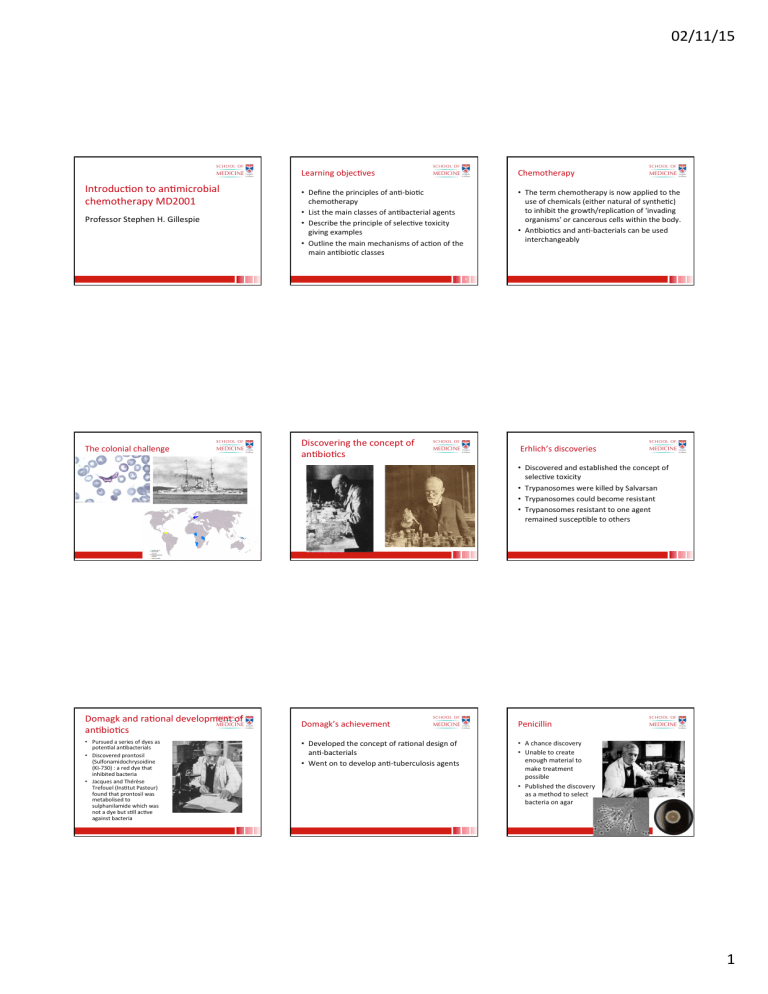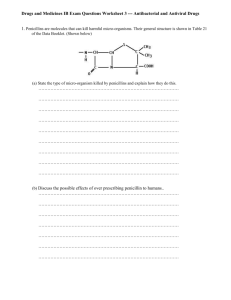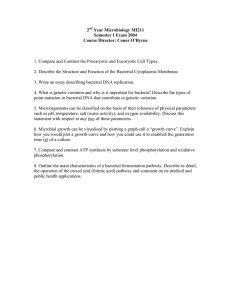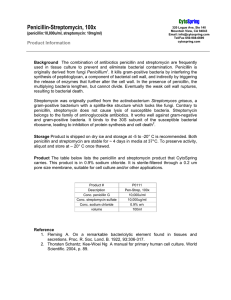
02/11/15 Introduc/on to an/microbial chemotherapy MD2001 Professor Stephen H. Gillespie Learning objec/ves Chemotherapy • Define the principles of an/-bio/c chemotherapy • List the main classes of an/bacterial agents • Describe the principle of selec/ve toxicity giving examples • Outline the main mechanisms of ac/on of the main an/bio/c classes • The term chemotherapy is now applied to the use of chemicals (either natural of synthe/c) to inhibit the growth/replica/on of 'invading organisms' or cancerous cells within the body. • An/bio/cs and an/-bacterials can be used interchangeably 2 The colonial challenge Discovering the concept of an/bio/cs Erhlich’s discoveries • Discovered and established the concept of selec/ve toxicity • Trypanosomes were killed by Salvarsan • Trypanosomes could become resistant • Trypanosomes resistant to one agent remained suscep/ble to others Domagk and ra/onal development of an/bio/cs • Pursued a series of dyes as poten/al an/bacterials • Discovered prontosil (Sulfonamidochrysoidine (KI-730) : a red dye that inhibited bacteria • Jacques and Thérèse Trefouel (Ins/tut Pasteur) found that prontosil was metabolised to sulphanilamide which was not a dye but s/ll ac/ve against bacteria Domagk’s achievement Penicillin • Developed the concept of ra/onal design of an/-bacterials • Went on to develop an/-tuberculosis agents • A chance discovery • Unable to create enough material to make treatment possible • Published the discovery as a method to select bacteria on agar 1 02/11/15 Florey and Chain • Recognised the value of penicillin as a poten/al treatment of bacterial infec/on • Used large fermenters to create enough star/ng material to allow extrac/on of penicillin • They worked in great secrecy during the war, later in America • The urine of treated pa/ents was collected and penicillin re-extracted The penicillin nucleus and the semi-synthe/c revolu/on Pre-1946 • Pelargonium roots • Cod liver oil • Gold Penicillin G Penicillin nucleus Ampicillin Waksman and Schatz • An/bio/c discovery based on a theory that soil organisms may have produced agents to kill mycobacteria which were derived from soil organisms • Thousands of soil samples were screened for the presence of factors that inhibit mycobacteria • Streptomycin discovered PRESENTER: KASHA SINGH The streptomycin trial – the long term results The streptomycin trial Treatment group Bed rest Streptomycin Total 52 55 Deaths assessed at 6m 14 4 Treatment Total group Deaths assessed 6m 5 yrs Bed rest 52 27% 62% Streptomycin 55 7% 58% 35 of 41 streptomycin pa/ents tested had developed resistance 27% 7% P = 0.01 14 Summary to date SELECTIVE TOXICITY • An/bio/cs can be developed based on a theory of ac/vity – even though it is subsequently proved to be false • An/bio/cs can be developed as a result of chance occurances • An/bio/cs can be discovered on the basis of systema/c screening of natural products • 1) Central to the use of chemotherapeu/c agents is the concept of SELECTIVE TOXICITY. These drugs are intended to be toxic to the invading organism or cancerous cell but be rela/vely harmless to the host or normal cells. • 2) This approach depends upon the existence of biochemical differences between the target group of cells and the host. 15 Examples of different selec/ve toxicity • Penicillins: in the absence of allergy have very low toxicity and high doses can be used • Aminoglycosides have a narrow THERAPEUTIC INDEX thus the dose that causes toxicity is very close to the therapeu/c dose • For an/-tuberculosis drugs such as isoniazid and pyrazinamide a number of pa/ents will develop hepatotoxicity that is not dose related and may require treatment to be stopped 18 2 02/11/15 An/bio/cs ac/ve against the cell membrane Figure 44.1 Diagrams of structure and metabolism of a bacterial cell. A Schematic representation of a bacterial cell. B Flow diagram showing the synthesis of the main types of macromolecule of a bacterial cell. Class I reactions result in the synthesis of the precursor molecules necessary for class II reactions, which result in the synthesis of the constituent molecules; these are then assembled into macromolecules by class III reactions. (Modified from: Mandelstam J, McQuillen K, Dawes I (eds) 1982 Biochemistry of bacterial growth, Blackwell Scientific, Oxford.) Downloaded from: StudentConsult (on 31 March 2005 06:02 PM) © 2005 Elsevier PEPTIDOGLYCANS Drug class Target Mechanisms Examples Beta-lactam and cephalosporin Penicillin binding proteins Preven/ng pep/doglycan crosslinking Penicillin G Flucloxacillin Tazobactam Glycopep/de C-terminal D-AlaD-Ala Prevents transglycola/on and transpep/da/on Vancomycin Teicoplanin Cyclic pep/de C 55- isoprenyl pyrophosphatE Prevents carriage of building-blocks of pep/doglycan bacterial cell wall outside of the inner membrane. Bacitracin Polymyxin Phosphonic acids murA protein Inhibits first stage of pep/doglycan synthesis Fosphomycin Lipopep/des Cell wall stress simulon Calcium-dependent membrane depolarisa/on Daptomycin • 1) They make up the cell wall of bacteria and do not occur in eukaryotes. • 2) Cell wall is made up from various numbers of strands of pep/doglycans • 3) The strands are made up mul/ples of amino-sugars; NACETYLGLUCOSAMINE & N-ACETLYMURAMIC ACID dimers. The n-acetylmuramic acid has a short pep/de side chain (hence pep/doglycan). • 4) The pep/de side chains are cross-linked to form a laqcework. • 5) Cross-linking gives the cell all its strength. 20 Penicillins • 1) Penicillins G & V. • 2) β-Lactamase-resistant Penicillins • Methicillin, Oxacillin, Nafcillin, Cloxacillin, Dicloxacillin. • 3) Broad-spectrum penicillins • Ampicillin & Amoxicillin. • 4) Extended-spectrum penicillins • Carbenicillin, Ticaracillin, Azlocillin, Piperacillin. Figure 44.2 Schematic diagram of a single layer of peptidoglycan from a bacterial cell (e.g. Staphylococcus aureus) showing the site of action of the β-lactam antibiotics (more detail in Fig. 44.3). In Staphylococcus aureus the peptide cross-links consist of five glycine residues. Gram-positive bacteria have several layers of peptidoglycan. (NAMA, N-acetylmuramic acid; NAG, N-acetylglucosamine.) Downloaded from: StudentConsult (on 31 March 2005 06:02 PM) © 2005 Elsevier Figure 44.3 Schematic diagram of the biosynthesis of peptidoglycan in a bacterial cell (e.g. Staphylococcus aureus) with the sites of action of various antibiotics. The hydrophilic disaccharide-pentapeptide is transferred across the lipid cell membrane attached to a large lipid (C55 lipid) by a pyrophosphate bridge (-P-P-). On the outside, it is enzymically attached to the 'acceptor' (the growing peptidoglycan layer). The final reaction is a transpeptidation, in which the loose end of the (gly)5 chain is attached to a peptide side-chain of an M in the acceptor and during which the terminal amino acid (alanine) is lost. The lipid is regenerated by loss of a phosphate group (Pi) before functioning again as a carrier. (M, N-acetylmuramic acid; G, N-acetylglucosamine.) Downloaded from: StudentConsult (on 31 March 2005 06:02 PM) © 2005 Elsevier CEPHALOSPORINS Bacterial Folate Antagonists. • 1) Come from the fungus Cephalosporium Acremonium. • 2) Work by the same mechanisms as penicillins • 3) Classified by generaTons in the order in which they were developed. • 1st, 2nd and 3rd generaTon. • 4) Now can be termed by means of administraTon; Oral is Cephalexin, Parenteral are Cefuroxime & Cefotaxime 1) SULPHONAMIDES & TRIMETHOPRIM • These are an/bio/cs which act through an inhibi/on of the folate pathway in bacteria. 2) Folate system important in cell metabolism 3) Bacteria must make their own supply but we don't as we get it in diet. 4) This makes bacteria suscep/ble to drugs which interfere with folate metabolism: thus we have our 'selec/ve toxicity' target. 5) Sulphonamides mark the beginning of an/microbial chemotherapy da/ng back to the 1930s and preceding the penicillins. Figure 45.1 Structures of two representative sulfonamides and trimethoprim. The structures illustrate the relationship between the sulfonamides and the p-aminobenzoic acid moiety in folic acid (orange box), and the possible relationship between the antifolate drugs and the pteridine moiety (orange). Co-trimoxazole is a mixture of sulfamethoxazole and trimethoprim. Downloaded from: StudentConsult (on 31 March 2005 06:02 PM) © 2005 Elsevier 3 02/11/15 AMINOGLYCOSIDES Streptomycin, Kanamycin, Neomycin, Gentamycin • 1) Form Ionic bonds at the cell surface • 2) Penetrate the cell wall by a a transport mechanism across the cell membrane. • 3) Diffuse into the cytoplasm and then binds to the bacterial ribosomes. Figure 45.2 The action of sulfonamides and trimethoprim on bacterial folate synthesis. See Figure 21.2 for more detail of tetrahydrofolate synthesis, and Table 44.1 for comparisons of antifolate drugs. (PABA, p-aminobenzoic acid.) Figure 44.4 Schematic diagram of bacterial protein synthesis indicating the points at which antibiotics inhibit the process. Downloaded from: StudentConsult (on 31 March 2005 06:02 PM) © 2005 Elsevier Downloaded from: StudentConsult (on 31 March 2005 06:02 PM) © 2005 Elsevier Chloramphenicol, Erythromycin & Clindamycin Inhibi/on of protein synthesis TETRACYCLINES • 1) Bind to the ribosomes • (i) At the interface between the assembled 30s and 50s subunits. • (ii) Directly to the individual subunits. • 2) Inhibits protein synthesis by • Misreading of mRNA. • 1) They prevent arachment of the tRNA to the acceptor (A) site on the mRNA-ribosomal complex. • 2) This prevents the addi/on of amino acids to the pep/de chain. • 3) Unlike the aminoglycosides, they are only weakly bound to the ribosomes. • 4) Differences in the ac/vity of individual tetracyclines are related to their solubility in the lipid membrane of the bacteria. • Prevent the addi/on of new amino acids to the growing pep/de chain by binding to the ribosomes. • This prevents associa/on of the pep/dyl-transferase with the amino acid and no pep/de bond is formed i.e. no transpep/da/on. • May also prevent transloca/on of the ribosome down the mRNA template (Erythromycin). FLUOROQUINOLONES. • These are synthe/c an/bio/cs recently introduced into clinical prac/ce. • Broad-spectrum agents: • Ciprofloxacin, ofloxacin, norfloxacin. • Narrower-spectrum drugs: • Cinoxacin and nalidixic acid (first introduced and is not fluorinated). • 1) Act by inhibi/ng bacterial DNA Topoisomerase II also known as DNA gyrase. • 2) This enzyme catalyses the introduc/on of nega/ve supercoil in DNA permiqng transcrip/on and replica/on. Figure 44.6 Schematic diagram of the action of DNA gyrase: the site of action for quinolone antibacterials. A Conventional diagram used to depict a bacterial cell and chromosome (e.g. Escherichia coli). Note that the E. coli chromosome is 1300 mm long and is contained in a cell envelope of 2 μm × 1 μm; this is approximately equivalent to a 50 m length of cotton folded into a matchbox. B Chromosome folded around RNA core, and then supercoiled by DNA gyrase (topoisomerase II). Quinolone and antibacterials interfere with the action of this enzyme. (Modified from: Smith J T 1985 In: Greenwood D, O'Grady F (eds) Scientific basis of antimicrobial therapy. Cambridge University Press, p. 69.) Downloaded from: StudentConsult (on 31 March 2005 06:02 PM) © 2005 Elsevier Figure 45.4 A simplified diagram of the mechanism of action of the fluoroquinolones. A An example of a quinolone (the quinolone moiety is shown in orange). B Schematic diagram of (left) the double helix and (right) the double helix in supercoiled form. (See also Fig. 44.6.) In essence, the DNA gyrase unwinds the RNA-induced positive supercoil (not shown) and introduces a negative supercoil. Downloaded from: StudentConsult (on 31 March 2005 06:02 PM) © 2005 Elsevier 4 02/11/15 Learning objec/ves • Define the principles of an/-bio/c chemotherapy • List the main classes of an/bacterial agents • Describe the principle of selec/ve toxicity giving examples • Outline the main mechanisms of ac/on of the main an/bio/c classes 37 5


